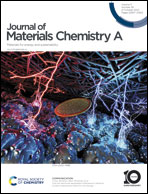Sustainable electricity from gravity-driven nanofluidic flow of water through modified bio-channels of coir fibers†
Abstract
Tremendous research efforts are being devoted towards extracting sustainable electricity from the pressure-driven flow of water through artificially fabricated channels of nanometer dimensions. Here, we demonstrate that the biofluidic channels of coconut (or coir) fibers (CFs) can be an ideal platform for generating electricity from nanofluidic transport. During the flow of water, the channels of CFs generated electrical signals up to 35 mV and 42 nA. Unlike typical electrokinetic energy harvesting devices, no energy was wasted to pump the liquids through the nanochannels of CFs; the gravity-driven flow of water was sufficient to generate power up to 5.66 mW m−2. The obtained electrical power is attributed to negative surface charges of the coir fibers, which ionize the water molecules flowing through the narrow channels. The power density obtained as such was drastically improved (up to 17-fold) upon modification of the delignified pores of CFs with two-dimensional flakes of graphene oxide (GO) and p-phenylenediamine (pPDA). The modification of the coir channels also resulted in a drastic improvement in the mechanical properties of CFs. The breaking stress and Young's modulus of CFs were increased by 671% and 3325% upon modification with GO and pPDA.



 Please wait while we load your content...
Please wait while we load your content...